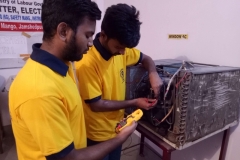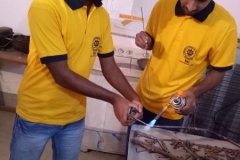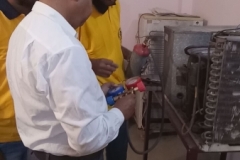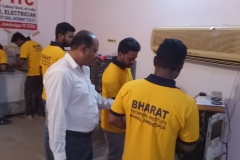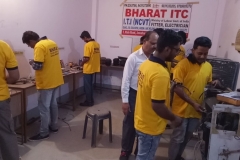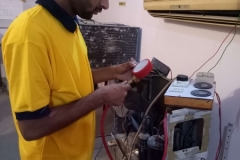Plant A/C Technician & Refrigeration + HVAC
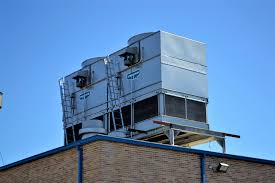 AC technicians, also called air conditioning mechanics and installers, specialize in the installation, maintenance or repair of air conditioning units in homes. Although technicians tend to specialize in one of the two areas, they are trained to be able to both install and perform maintenance/repairs on AC units.
AC technicians, also called air conditioning mechanics and installers, specialize in the installation, maintenance or repair of air conditioning units in homes. Although technicians tend to specialize in one of the two areas, they are trained to be able to both install and perform maintenance/repairs on AC units.
AC technicians, also called air conditioning mechanics and installers, specialize in the installation, maintenance or repair of air conditioning units in homes. Although technicians tend to specialize in one of the two areas, they are trained to be able to both install and perform maintenance/repairs on AC units.
REFRIGERATION
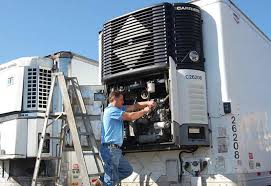 Refrigeration Mechanics (also called Refrigeration and Air Conditioning Mechanics) work with industrial, commercial and domestic refrigeration, air-conditioning and heating systems. They are specialists in installing, testing, servicing and repairing these systems.
Refrigeration Mechanics (also called Refrigeration and Air Conditioning Mechanics) work with industrial, commercial and domestic refrigeration, air-conditioning and heating systems. They are specialists in installing, testing, servicing and repairing these systems.
Role Requirements for HVAC Professionals
Today, most HVAC technicians begin by taking courses at a technical school or community college. Shorter programs may last only six months and result in an HVAC technician certificate, while longer programs can last up to two years and result in an associate degree.
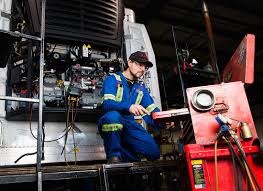 Refrigeration is a technology that most of us in the western world take for granted, but it’s impact on our lives and on society have been immense. Refrigeration is responsible for drops in food prices that led to better nutrition across social classes; for freeing us from pickling, potting, drying salting, or canning as the only means of food preservation; for suppressing the growth of food-borne bacteria; and for allowing us to eat food that tastes fresh almost all the time.
Refrigeration is a technology that most of us in the western world take for granted, but it’s impact on our lives and on society have been immense. Refrigeration is responsible for drops in food prices that led to better nutrition across social classes; for freeing us from pickling, potting, drying salting, or canning as the only means of food preservation; for suppressing the growth of food-borne bacteria; and for allowing us to eat food that tastes fresh almost all the time.
Well-trained and knowledgeable HVAC refrigeration technicians not only keep our food cold, edible, and fresh, but their training is incredibly important to keeping our earth healthy through keeping greenhouse gases in check, and stemming the spread of food-borne illness. The proper removal, storage, purification, and reuse of refrigerant chemicals will be a major force for good in humankind’s global efforts to prevent major climate catastrophe. A refrigeration technician is there for families, stores, office buildings, and hospitals when their refrigeration units stop working. They also help install new refrigeration systems. These trained technicians have the skills and experience to troubleshoot refrigeration issues in many different scenarios. Most refrigeration technicians are trained in all areas of HVAC systems and once they have entered the workforce, they may have chosen to focus on refrigeration.
While refrigeration technicians may work on climate control systems (e.g., air conditioning) for residential buildings, most commonly, their work involves commercial refrigeration for food storage, transportation, and other industrial applications. Refrigeration technicians must also be trained in proper disposal of HFCs and other chemical refrigerants.
Keep reading to learn more about what the day-to-day tasks of a refrigeration technician look like, as well as what steps are necessary to become one.
HVAC
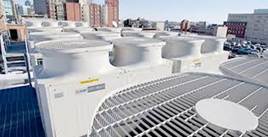 The acronym HVAC stands for heating, ventilation and air conditioning, and it’s the broadly used term to describe equipment used to keep homes at a comfortable temperature. In the residential sector, most HVAC systems in Texas are forced-air heating and cooling systems that include heat pumps, air conditioners and furnaces.
The acronym HVAC stands for heating, ventilation and air conditioning, and it’s the broadly used term to describe equipment used to keep homes at a comfortable temperature. In the residential sector, most HVAC systems in Texas are forced-air heating and cooling systems that include heat pumps, air conditioners and furnaces.
HVAC Components
Forced-air systems have two major components. The first is the indoor air handler unit that houses some of the cooling system’s parts and most of those associated with the furnace. A central air conditioner and a heat pump both use outdoor condensers that contain the condensing coil, the compressor and a fan. The V in HVAC stands for ventilation, and the blower motor in the air handler pulls air over the heating and cooling components, conditioning your air and sending it through the ductwork.
How They Work
 Central air conditioners and heat pumps use refrigerant to capture the heat in the indoor air. During the cooling cycle, the compressor alters the refrigerant pressure that chills it. It flows through the evaporator coil in the air handler, and the blower sends air over the coil, removing the heat. A heat pump reverses the refrigerant flow in the winter to warm the air.
Central air conditioners and heat pumps use refrigerant to capture the heat in the indoor air. During the cooling cycle, the compressor alters the refrigerant pressure that chills it. It flows through the evaporator coil in the air handler, and the blower sends air over the coil, removing the heat. A heat pump reverses the refrigerant flow in the winter to warm the air.
During the cooling cycle, the warmed refrigerant then circulates through the condensing coil while a fan pulls air through the coil to cool it. Air returns to the compressor and back into the evaporator coil until your home reaches the thermostat’s setting.
Gas furnaces have a burner inside the air handler and an electronic or standing pilot that lights the fuel to create heat. A heat exchanger adjacent to the burner heats up and the blower motor sends air over it. As it blows the air through the ductwork, your home warms.







